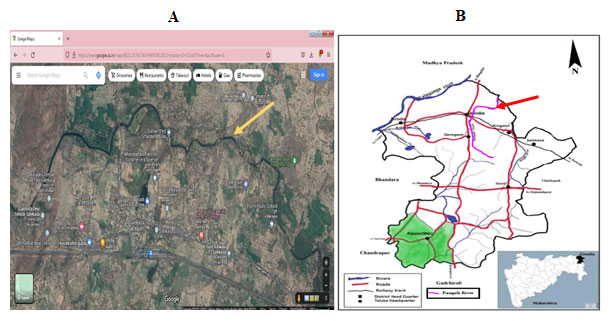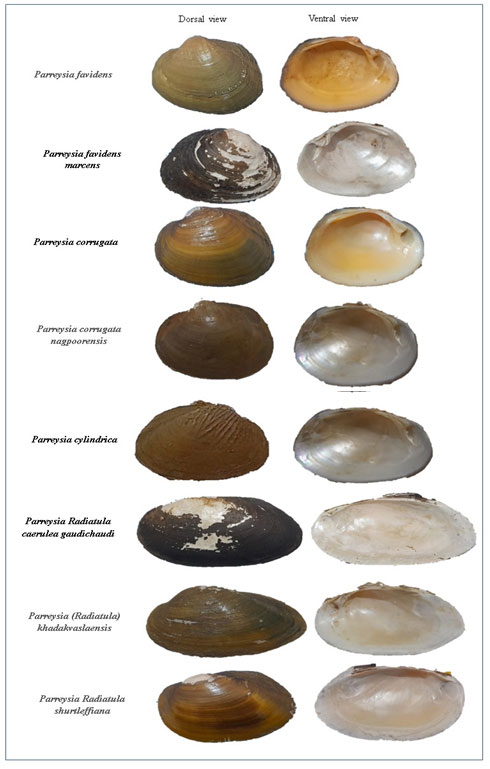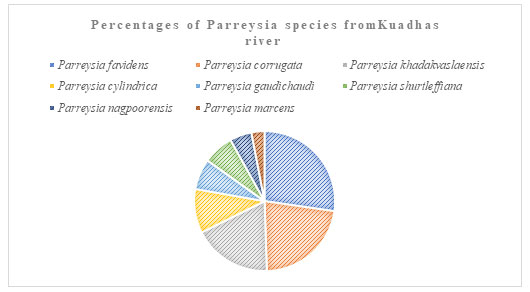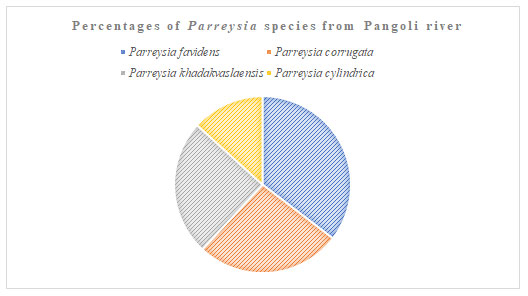1Department of Zoology, Shankarlal Agrawal Science College Salekasa, District Gondia, Maharashtra, India.
2Department of Zoology, Shri. Dr. R. G. Rathod Arts and Science College Murtizapur District Akola, Maharashtra, India.
Corresponding author email:gaurithakre2018@gmail.com
Article Publishing History
Received: 25/06/2023
Accepted After Revision: 24/09/2023
Aquatic environments benefit greatly from the contribution of freshwater bivalves. They are crucial for ancient remedies, and a variety of industrial uses, primarily the manufacturing of pearls, slacked lime, and use as a food source in various regions Malacofauna was assessed from Kuadhas river and Pangoli river of Gondia Maharashtra for six months. The physicochemical parameters comprising pH, turbidity, color, nitrate, sulfate, phosphate, silica, free carbon dioxide, alkalinity, dissolved oxygen, and total hardness were evaluated since aquatic body water quality has an impact on the occurrence and survival of flora and fauna. This paper deals particularly with different species and varieties from the genus Parreysia among freshwater bivalves.
From study sites genus Parreysia represents total 8 species as Parreysia favidens, Parreysia favidens marcens, Parreysia corrugata, Parreysia corrugata nagpoorensis, Parreysia cylindrica, Parreysia Radiatula shurtleffiana, Parreysia (Radiatula) khadakvaslaensis, Parreysia Radiatula caerulea gaudichaudi. Bivalve occurrence peaked in the post-monsoon season and declined during the monsoon. Parreysia favidens and Parreysia corrugata are widely distributed in the Kuadhas River. The two major species in the Pangoli River are Parreysia (Radiatula) khadakvaslaensis and Parreysia favidens. In both rivers Parreysia favidens marcens, Parreysia corrugata nagpoorensis, and Parreysia Radiatula shurtleffiana are listed as being rarer species.
Freshwater Bivalves, Gondia District, Maharashtra, Malacofauna, Physicochemical Parameters.
Ade G. V, Makode P. M. Analyzing the Bivalve Species of Genus Parreysia Along With Water Quality of Kuadhas And Pangoli Rivers From Gondia Maharashtra, India. Biosc.Biotech.Res.Comm. 2023;16(3).
Ade G. V, Makode P. M. Analyzing the Bivalve Species of Genus Parreysia Along With Water Quality of Kuadhas And Pangoli Rivers From Gondia Maharashtra, India. Biosc.Biotech.Res.Comm. 2023;16(3). Available from:
<a href=”http://surl.li/lpuas“>http://surl.li/lpuas</a>
INTRODUCTION
Freshwater mollusks contribute significantly to the biogeochemical cycle and are an essential component of the aquatic ecosystem (Dey, 2007). Among molluscs, bivalves don’t have head like that of gastropods. Externally structure consisting of two valves made up of calcium carbonate and joined together by soft ligament at a hinge. Inside the shell have mantle secreted by shell enclosing visceral mass, two pairs of gills and foot ( Rao, 1989). In rivers and lakes, freshwater bivalves serve as filters. Numerous species can be found in dense clusters and filter out a lot of silt, bacteria, diatoms, blue-green algae, and other microscopic organisms as well as heavy metals and big organic compounds. Genus Parreysia of class Bivalvia, comes under subclass Palaeoheterodonta and family Unionidae of phylum Mollusca (Rao, 1989).
Some species of Parreysia are used as food sources such as Parreysia favidens, Parreysia caerulea. Soup made from Parreysia favidens, intended to treat blood pressure and heart issues also shell lime water is used to cure intestinal parasites (Tripathy and Mukhopadhayay, 2015). Molluscs distribution and abundance in water bodies are influenced by physicochemical parameters and the vegetation of the water body (Choubisa, 1992). Bad water quality and other human activities, leading to habitat destruction, effects on survival and diminishing diversity of sensitive malacofauna.
In India molluscan diversity and relation to physicochemical properties studied recently by number of researchers including, Chutia and Kardong (2021), Kumar et al., (2019), Padghane et al., (2017), Kamble (2018). Sarwade et al., (2015). Gondia situated north-eastern site of Maharashtra state most of the land of district is covered with forest and lakes and rivers. It is in the northeastern region of Maharashtra state, and most of the district’s territory is covered in rivers, lakes, and forests. In this area little or no work is done on malacofaunal diversity hence This paper particularly enlists species of genus Parreysia from Kuadhas and Pangoli rivers of Gondia Maharashtra along with information on some physicochemical parameters of these water bodies.
MATERIAL AND METHOS
Gondia district in the Indian state of Maharashtra. It is located between latitudes 20.39 and 21.38 North and 79.27 and 80.42 East. As most of the territory is covered by forests, the Gondia district of Maharashtra is home to a wide variety of plants and animals. Kuadhas river originates from Darekasa hills of the district and is a sub-tributary of Bagh River of the region. Pangoli river has it’s beginning from Tumsar hills of the district and is tributary of Bagh River (Figure 1).
Kuadhas and Pangoli rivers were visited from November 2022 to April 2023. The quadrate sampling method was used to perform the quantification (Christian and Harris 2005). Samples were collected from bank of rivers by hand picking and with the help of hand net and scoop net. (Rao et al., 1989). (Only molluscan shells are used for study and no live molluscs were brought to laboratory for analysis). After being transported to the lab, the shells were cleaned with a soft bristle brush to avoid breaking the shells and to properly clean the mud for shell character identification. Identification of malacofauna was done by following keys by Rao (1989), Ramkrishna and Dey (2005).
Water samples were collected from both rivers at the same time and analysed for thirteen water parameters as temperature, pH, color, turbidity, total dissolved solids, total hardness, alkalinity, free carbon dioxide, dissolved oxygen, silica, phosphate, sulphate and nitrate of water sample. The physicochemical analysis of water was performed as per standard methods, (APHA, 1998; Trivedi and Goel 1984).
RESULT AND DISCUSSION
The studied physicochemical parameters of water samples from Kuadhas river and Pangoli river have been given in Table 1. The physicochemical parameters of Kuadhas river were recorded as: water temperature (24 – 310 C), pH ( 7.0-7.52), Color (BQL), Turbidity (1.5- 2.61 NTU), Phosphate (BQL- 0.29 mg/L), Sulphate (8.73-10.38 mg/L), Nitrate (1.14- 3.86 mg/L), Total Dissolved Solids (82- 224 mg/L), Alkalinity (42-104 mg/L), Total Hardness (45-130 mg/L), Dissolved Oxygen (5.50-6.80 mg/L), Silica (BQL – 4.24mg/L), Free CO2 (3.17-7.4 mg/L).
As compared to Kuadhas river, the upper and lower limits of water parameters of Pangoli river had higher: temperature (23.6 – 320 C), pH ( 7.33-7.67), Color (BQL-3 Hazen), Turbidity (3.8- 23.1 NTU), Phosphate (BQL- 4.43 mg/L), Sulphate (2.94-17.26 mg/L), Nitrate (1.5- 16.16 mg/L), Total Dissolved Solids (106-322 mg/L), Alkalinity (55-124mg/L) Total Hardness (55-130 mg/L), Dissolved Oxygen (5.8-6.7 mg/L), except Silica (0.31 – 4.12mg/L) and Free CO2 (3.0-5.28 mg/L). Positive correlation between molluscan population and total hardness, alkalinity, chlorides, phosphates, nitrate- nitrogen by many researchers (Garg et al 2009; Dorlikar et al., 2014; Sarwade et al., 2015).
Figure: 1 Location of study area Kuadhas river (A) and Pangoli river (B)

In the present work, we have reported species from genus Parreysia of family Unionidae of bivalves from Kuadhas and Pangoli rivers of Gondia district Maharashtra India (Figure 2). All eight species of Genus Parreysia were found at Kuadhas river from November 2022 to April 2023 includes, Parreysia favidens, Parreysia favidens marcens, Parreysia corrugata, Parreysia corrugata nagpoorensis, Parreysia cylindrica, Parreysia Radiatula shurtleffiana, Parreysia (Radiatula) khadakvaslaensis, Parreysia Radiatula caerulea gaudichaudi. Parreysia favidens followed by Parreysia corrugata are most abundant species found at Kuadhas river and Pangoli river. Parreysia corrugata nagpoorensis and Parreysia favidens marcens as rare species at study area. Only four species of Parreysia were reported from Pangoli river includes Parreysia favidens, Parreysia corrugata, Parreysia (Radiatula) khadakvaslaensis and Parreysia cylindrica (Figure 3 and 4).
Kuadhas river showed maximum diversity of molluscs due to present of phytoplankton vegetation serve as food for molluscs, less anthropogenic activity found at this river. Least diversity and molluscan assemblage found at Pangoli river due to habitat destruction as number of small dams built across the river and other anthropogenic activities.
Table.1 Physicochemical analysis of Kuadhas river and Pangoli
river in Gondia district Maharashtra, India
| Study Sites
|
Kuadhas River
|
Pangoli River | ||
| Water Parameters | Minima | Maxima | Minima | Maxima |
| Temperature (0C) | 24 | 31 | 23.6 | 32 |
| pH | 7.0 | 7.52 | 7.33 | 7.67 |
| Color (Hazen) | —— | BQL | BQL | 3 |
| Turbidity (NTU) | 1.5 | 2.61 | 3.8 | 23.1 |
| Phosphate (mg/L) | BQL | 0.29 | BQL | 4.43 |
| Sulphate (mg/L) | 8.73 | 10.38 | 2.94 | 17.26 |
| Nitrate (mg/L) | 1.14 | 3.86 | 1.50 | 16.16 |
| Total Dissolved Solids (mg/L) | 82 | 224 | 106 | 322 |
| Alkalinity (mg/L) | 42 | 104 | 55 | 124 |
| Total Hardness (mg/L) | 45 | 130 | 55 | 130 |
| Dissolved Oxygen (mg/L) | 5.50 | 6.80 | 5.8 | 6.7 |
| Silica (mg/L) | BQL | 4.24 | 0.31 | 4.12 |
| Free CO2 (mg/L) | 3.17 | 7.4 | 3.0 | 5.28 |
Figure:2 Collected and identified Parreysia species from Kuadhas river and
Pangoli river of Gondia district Maharashtra, India

Figure: 3 Percentages of Parreysia species from Kuadhas river.

Figure:4 Percentage of Parreysia species from Pangoli river

CONCLUSION
Eight species of genus Parreysia were recorded from two rivers Kuadhas and Pangoli rivers from Gondia district Maharashtra during six months of the survey. This is the first attempt to study malacofauna in this region and will help to explore malacofauna and development of conservation policies to protect the species in the near future. Further study will be continued for a longer period and from different water bodies of the region to enlist molluscan diversity and their seasonal variations.
REFERENCES
APHA (1998). Standard methods for examinations of water and waste water, 20th Editions Washington, DC. 169 pp.
Choubisa, S.L., 1992. Molluscs as bio-indicators for the trophic stages of lakes and lotic environments. Bulletin of Pure and Applied Science, 11, pp.35-40.
Christian, A.D. and Harris, J.L., 2005. Development and assessment of a sampling design for mussel assemblages in large streams. The American midland naturalist, 153(2), pp.284-292.
Chutia, J. and Kardong, D., 2021. Current status and seasonal distribution of malacofaunal assemblage in Poba Reserve Forest in relation to certain physico-chemical parameters. Asian Journal of Biological and Life Sciences, 10(1), pp.93-100.
Dey, A., 2007. Handbook on Indian freshwater molluscs. AICOPTAX–Mollusca, Zoological Survey of India.
Dorlikar, A.V., Mohite, A.S. and Charde, P.N., 2014. Correlation of molluscan diversity with physicochemical characteristics of water of Gorewada reservoir, Nagpur, India. International Journal of Life Sciences, Special Issue A, 2, pp.197-201.
Garg, R.K., Rao, R.J. and Saksena, D.N., 2009. Correlation of molluscan diversity with physico-chemical characteristics of water of Ramsagar reservoir, India. International Journal of Biodiversity and Conservation, 1(6), pp.202-207.
Gondia Gazetteer (2021). Database of Gondia District redirected from official website of Gondia District (M.S.), India, www.gondia.nic.in.
Kamble, V.S., 2018. Study of diversity of freshwater molluscs from drought prone region Sangola, district Solapur (MS), India. J Emerg Technol Innov Res, 5(8).
Kumar, R. and Maansi, W.M., 2019. Molluscan Biodiversity and its seasonal fluctuations in Teekar Taal, Haryana. Indian International Journal of Research-Granthalayah, 7(1), pp.169-178.
Padghane, S., Chavan, S., Dudhmal, D. and Walke, D., 2017. Mollusc diversity and its role as a food for crabs and water birds in Godavari River Basin Nanded (MS), India. International Journal of Advanced Scientific and Technical Research, 7, pp.149-161.
Rao S N.V., 1989. Handbook, freshwater molluscs of India.
Sarwade, A.B., Pati, S.K. and Kamble, N.A., 2015. Diversity of molluscan fauna from freshwater bodies of Sangli district: A comprehensive study in relation to environmental variables. International Journal of Pharmaceutical Sciences and Research, 6(8), p.3563.
Tripathy, B. and Mukhopadhayay, A., 2015. Freshwater molluscs of India: an insight of into their diversity, distribution and conservation. Aquatic Ecosystem: Biodiversity, Ecology and Conservation, pp.163-195.
Trivedy, R.K. and Goel, P.K., 1984. Chemical and biological methods for water pollution studies. Environmental publications.


